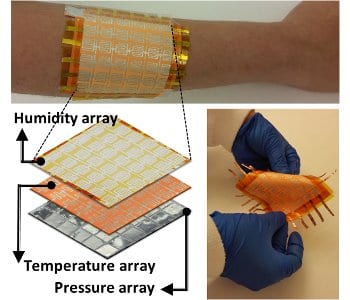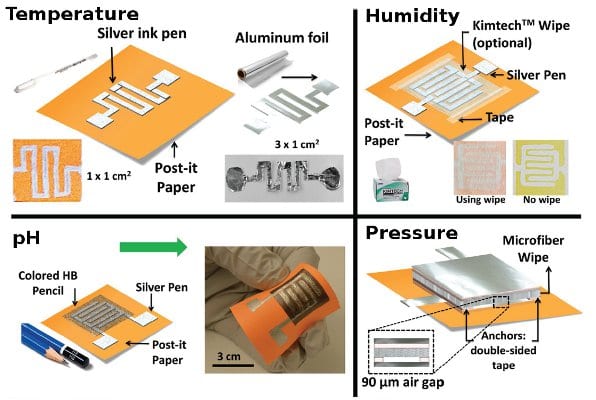 Using only off-the-shelf components, researchers in Saudi Arabia have designed and built an affordable and multifunctional artificial skin sensor based on recyclable materials including paper and aluminium foil. The extraordinary “paper skin” integrates a myriad of real-time sensing functions designed to mimic the range of human skin sensing, including temperature, pressure, humidity and air flow.
Using only off-the-shelf components, researchers in Saudi Arabia have designed and built an affordable and multifunctional artificial skin sensor based on recyclable materials including paper and aluminium foil. The extraordinary “paper skin” integrates a myriad of real-time sensing functions designed to mimic the range of human skin sensing, including temperature, pressure, humidity and air flow.
The foundation for the paper skin is Post-it note paper. Each of the sensors are built onto a Post-it note base, with the temperature, humidity, and multifunctional pressure sensors then stacked to form the multifunctional paper skin. Each of the layers was divided into a 6 x 6 array of ‘pixels’, with 1 mm separation between the pixels, so that localized sensor measurements could be determined. The single pixels are independently operated, which enables simultaneous sensing of localized effects.
The temperature sensor is drawn directly onto the paper using conductive pen. The principle of operation is the change in resistance of the conductive traces as the temperature varies, due to increase in vibrations of the lattice structure of the silver in the conductive ink. The humidity sensor operates on capacitive principles. The paper itself is used as the dielectric material, with electrodes draw directly onto the paper using conductive ink. The porous structure of the paper readily absorbs moisture from the air, and there is a marked change in the capacitance of the sensor due to the adsorption of hydroxyl groups from the water onto the paper.
The pressure sensor is a multifunctional unit, enabling detection of force, airflow, and proximity in a single sensor unit. This sensor also uses a capacitive mechanism of operation, with an air gap as the dielectric medium. The electrodes are constructed of aluminium foil, and the sensor is built onto a paper base for stability. Compression of the air gap results in altered capacitance, and allows pressure to be detected. The air-gap capacitor is highly sensitive, due to the high compressibility of air, and can detect touch and air flow even at tangential angles. The structure is sensitive enough to detect a human heartbeat from the tip of a finger. It is also possible to track the motion of pressure across the paper skin in real-time.
Proximity detection is also achieved using the pressure sensor. The electric field of the capacitor extends a large distance from the sensor itself, and any conductive item—including parts of the human body—disrupts the field. This disruption affects the capacitance, and can be detected. The paper-based pressure sensor can detect a nearby conductive object at distances of up to 13 cm.
The paper skin is also demonstrated to have potential as a pH sensor. pH sensing on the paper sensor is essentially destructive, as it requires that the paper be saturated. Nevertheless, such a fu
nction could prove useful in several applications, including food storage, due to the simplicity and low cost of fabrication. The pH sensor operates vie measuring resistance changes in HB pencil traces on the paper, as the graphite is reduced by alkaline solutions, and oxidized by acids.
The temperature sensing performance of the paper skin is of a comparable level to that of current, cutting edge research into artificial skin systems. A good performance is achieved for the humidity sensor as well, with fast response and recovery times due to the porosity of the paper. For pressure measurements, the sensing performance of the paper skin is found to be around 10% less sensitive for pressure, compared to other artificial skin systems that approach the sensitivity of human skin. However, the majority of artificial skin systems currently reported integrate fewer features than those demonstrated by the paper skin, and at vastly higher costs, with multi-step fabrication processes.
Paper has been used in a variety of applications where flexibility and low cost is required. In these applications, including actuators, displays, and antennas, the paper is functionalized using expensive processing techniques. As noted, artificial skin suffers similar cost-efficiency problems. The paper based artificial skin therefore offers a promising and attractive route to inexpensive flexible sensing applications, particularly due to its simple fabrication methods, and use of recyclable materials. These exciting new sensors can be easily imagined to have a range of applications in household and health applications, for real-time monitoring and as flexible touchscreen interfaces for appliances and devices.

















